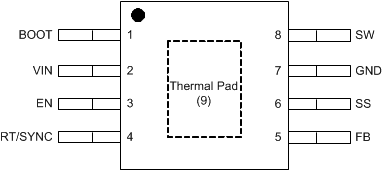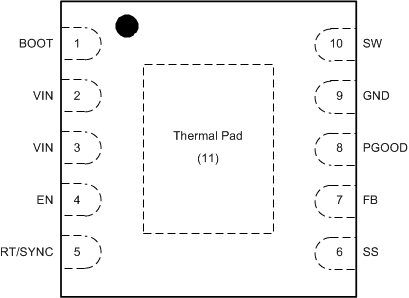SNVSAG2B November 2015 – December 2024 LMR14050-Q1
PRODUCTION DATA
- 1
- 1 Features
- 2 Applications
- 3 Description
- 4 Pin Configuration and Functions
- 5 Specifications
-
6 Detailed Description
- 6.1 Overview
- 6.2 Functional Block Diagram
- 6.3
Feature Description
- 6.3.1 Fixed Frequency Peak Current Mode Control
- 6.3.2 Slope Compensation
- 6.3.3 Sleep-mode
- 6.3.4 Low Dropout Operation and Bootstrap Voltage (BOOT)
- 6.3.5 Adjustable Output Voltage
- 6.3.6 Enable and Adjustable Undervoltage Lockout
- 6.3.7 External Soft-start
- 6.3.8 Switching Frequency and Synchronization (RT/SYNC)
- 6.3.9 Power Good (PGOOD)
- 6.3.10 Overcurrent and Short-Circuit Protection
- 6.3.11 Overvoltage Protection
- 6.3.12 Thermal Shutdown
- 6.4 Device Functional Modes
- 7 Application and Implementation
- 8 Device and Documentation Support
- 9 Revision History
- 10Mechanical, Packaging, and Orderable Information
パッケージ・オプション
メカニカル・データ(パッケージ|ピン)
サーマルパッド・メカニカル・データ
- DDA|8
発注情報
4 Pin Configuration and Functions
 Figure 4-1 DDA Package8-Pin (HSOIC)Top View
Figure 4-1 DDA Package8-Pin (HSOIC)Top View Figure 4-2 DPR Package10-Pin (WSON)Top View
Figure 4-2 DPR Package10-Pin (WSON)Top ViewTable 4-1 Pin Functions
| NAME | NO. | TYPE (1) | DESCRIPTION | |
|---|---|---|---|---|
| SO-8 | WSON-10 | |||
| BOOT | 1 | 1 | P | Bootstrap capacitor connection for high-side MOSFET driver. Connect a high quality 0.1 μF capacitor from BOOT to SW. |
| VIN | 2 | 2, 3 | P | Connect to power supply and bypass capacitors CIN. Path from VIN pin to high frequency bypass CIN and GND must be as short as possible. |
| EN | 3 | 4 | A | Enable pin, with internal pull-up current source. Pull below 1.2 V to disable. Float or connect to VIN to enable. Adjust the input under voltage lockout with two resistors. See the Enable and Adjusting Under voltage lockout section. |
| RT/SYNC | 4 | 5 | A | Resistor Timing or External Clock input. An internal amplifier holds this pin at a fixed voltage when using an external resistor to ground to set the switching frequency. If the pin is pulled above the PLL upper threshold, a mode change occurs and the pin becomes a synchronization input. The internal amplifier is disabled and the pin is a high impedance clock input to the internal PLL. If clocking edges stop, the internal amplifier is re-enabled and the operating mode returns to frequency programming by resistor. |
| FB | 5 | 7 | A | Feedback input pin, connect to the feedback divider to set VOUT. Do not short this pin to ground during operation. |
| SS | 6 | 6 | A | Soft-start control pin. Connect to a capacitor to set soft-start time. |
| PGOOD | N/A | 8 | A | Open drain output for power-good flag. Use a 10 kΩ to 100 kΩ pull-up resistor to logic rail or other DC voltage no higher than 7V. |
| GND | 7 | 9 | G | System ground pin. |
| SW | 8 | 10 | P | Switching output of the regulator. Internally connected to high-side power MOSFET. Connect to power inductor. |
| Thermal Pad | 9 | 11 | G | Major heat dissipation path of the die. Must be connected to ground plane on PCB. |
(1) A = Analog, P = Power, G = Ground